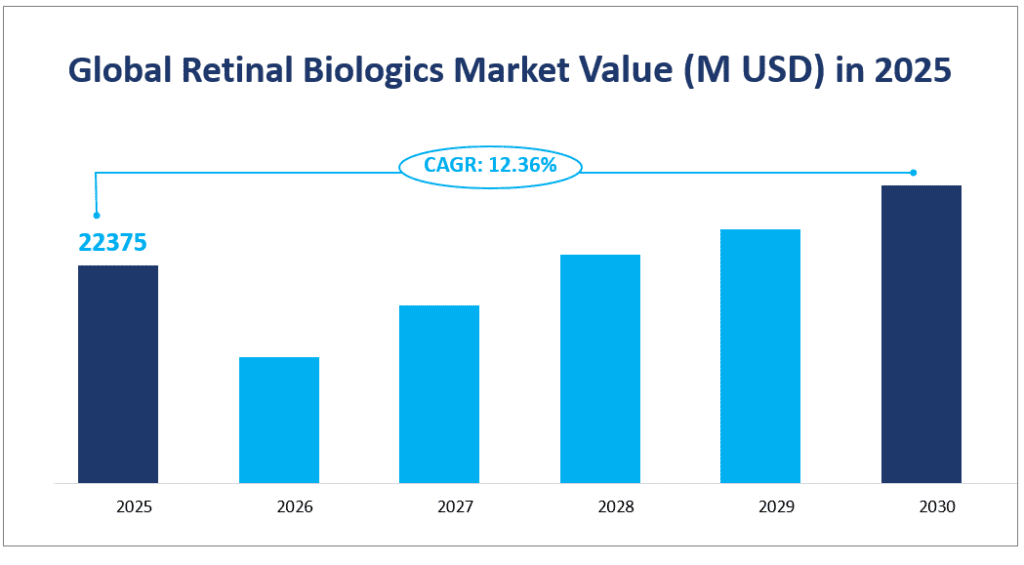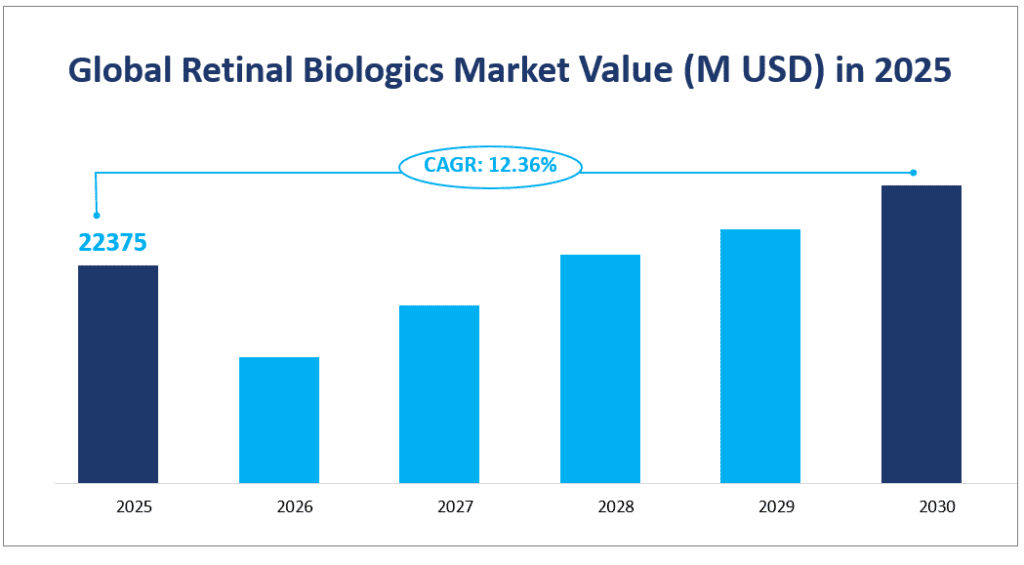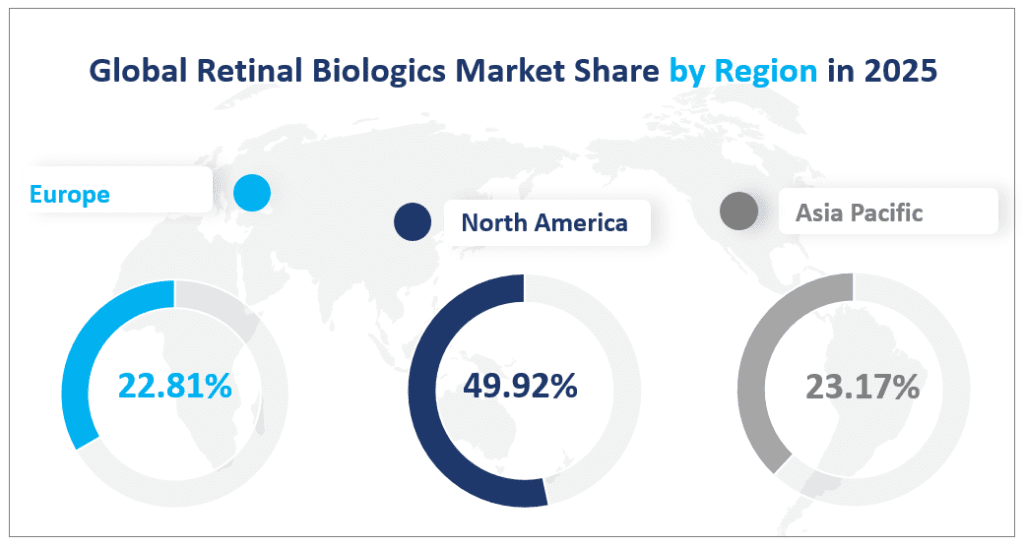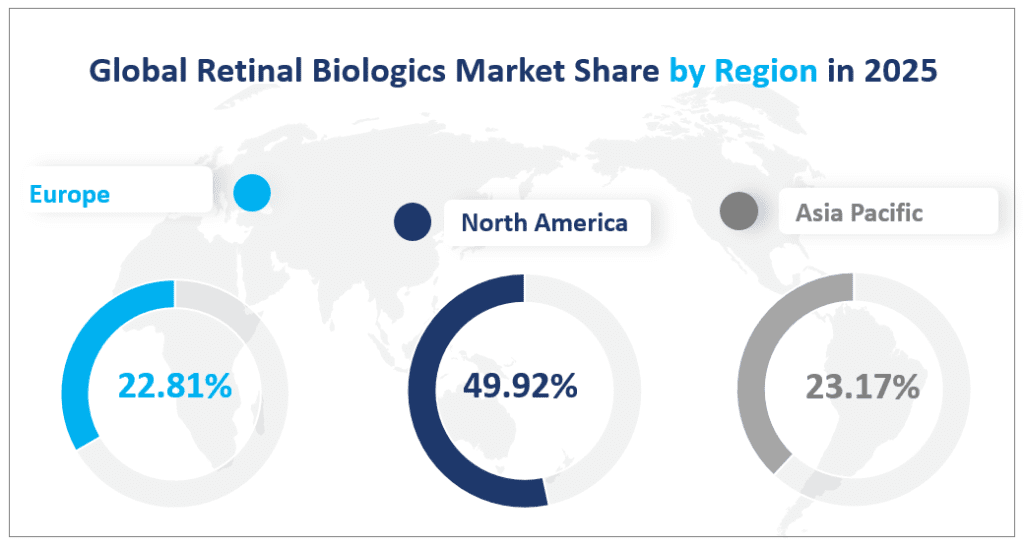1. Global Retinal Biologics Market Size and Growth Projections
The global retinal biologics market size is projected to reach approximately $22,375 million with a CAGR of 12.36% from 2025 to 2030.
Retinal biologics are a class of bioengineered molecules designed to treat chronic retinal diseases. These biologics are typically produced from living organisms such as microorganisms, or animal or plant cells. They are implanted inside the eye to address various retinal conditions, including age-related macular degeneration, diabetic retinopathy, diabetic macular edema, and uveitis. The primary goal of these treatments is to prevent vision loss and improve the quality of life for patients suffering from these debilitating eye conditions.
Global Retinal Biologics Market Value (M USD) in 2025


2. Driving Factors of Retinal Biologics Market
Increasing Prevalence of Retinal Diseases: The rising incidence of age-related macular degeneration, diabetic retinopathy, and other retinal diseases is a major driver of the market. The International Diabetes Federation (IDF) estimates that the global population with diabetes mellitus will increase from 463 million in 2019 to 700 million by 2045. Diabetic retinopathy is a common complication of diabetes and a leading cause of preventable blindness in adults. This increasing burden of retinal diseases is driving the demand for effective treatments.
Technological Advancements: Significant progress in biotechnology and pharmaceutical research has led to the development of innovative biologics and delivery systems. The approval of anti-VEGF drugs, intravitreal implants, and steroid-releasing injections by regulatory bodies such as the FDA, EMA, and CFDA has further boosted the market. These advancements are expected to improve patient outcomes and expand the market size.
Government Support and Policies: Governments and regulatory bodies are providing support through funding, tax incentives, and streamlined approval processes. These policies are encouraging pharmaceutical companies to invest in research and development, thereby driving innovation and market growth.
3. Limiting Factors of Retinal Biologics Market
High Development Costs: The development of retinal biologics is a capital-intensive process, requiring significant investment in research, clinical trials, and manufacturing. The high costs associated with these activities can be a barrier for smaller companies, limiting their ability to enter the market.
Side Effects and Safety Concerns: Some retinal biologics may cause serious side effects, such as eye infections, increased intraocular pressure, and cataract formation. These safety concerns can impact patient acceptance and market adoption of these treatments.
Regulatory Challenges: The approval process for new biologics is rigorous and time-consuming. Regulatory requirements can vary by country, adding complexity and delays to the commercialization process. This can limit the speed at which new treatments reach the market.
Market Saturation and Competition: The retinal biologics market is highly competitive, with a few major players dominating the space. New entrants face significant challenges in gaining market share, especially without a unique value proposition or significant technological advantage.
4. Analysis of the Global Retinal Biologics Market Segment
Product Types
The macular degeneration treatments market is projected to grow at a robust rate with a market size of $8,125 million in 2025, driven by the increasing prevalence of age-related macular degeneration (AMD) among the aging population. Anti-VEGF therapies, such as Eylea (aflibercept) and Lucentis (ranibizumab), have become the standard of care for wet AMD, contributing significantly to the market size. The development of new formulations and delivery systems is expected to further enhance the market growth.
Diabetic retinopathy is a leading cause of vision loss among diabetic patients. The market for treatments targeting this condition is growing rapidly with a market size of $7,032 million in 2025, driven by the increasing incidence of diabetes worldwide. Anti-VEGF drugs and intravitreal implants have shown significant efficacy in managing diabetic retinopathy, fueling the market expansion. The market is expected to continue its growth trajectory, supported by ongoing research and development efforts.
Diabetic macular edema (DME) is a complication of diabetic retinopathy that affects the macula, leading to vision impairment with a market value of $4,439 million in 2025. Treatments for DME, including anti-VEGF therapies and corticosteroid implants, have shown promising results. The market for DME treatments is growing steadily, driven by the increasing prevalence of diabetes and the need for effective therapies to prevent vision loss.
Uveitis, characterized by inflammation of the uveal tract of the eye, requires targeted treatments to prevent complications such as vision loss. The market for uveitis treatments is growing with a market revenue of $2,042 million in 2025, driven by the increasing adoption of biologics and corticosteroids. The development of new therapies and the expansion of existing treatments are expected to drive the market forward.
Retinal Biologics Market Applications
Hospitals account for the largest share of the retinal biologics market with a market size of $15,367 million in 2025, driven by the increasing number of hospital visits for the diagnosis and treatment of retinal diseases. The growth is further supported by the availability of advanced diagnostic and treatment facilities in hospitals. The market is expected to continue its growth, driven by the increasing prevalence of retinal diseases and the need for specialized care.
The market for retinal biologics in clinics is growing with a market revenue of $5,860 million in 2025, driven by the increasing number of specialized ophthalmic clinics and the convenience they offer to patients. The high degree of accessibility and dedicated services provided by clinics are promoting the adoption of retinal biologics. The market is expected to grow steadily, supported by the increasing incidence of retinal diseases and the expansion of clinic networks.
Hospitals hold the largest market share, driven by the comprehensive care and advanced treatment options available. The high prevalence of retinal diseases and the increasing number of hospital visits for diagnosis and treatment are key factors supporting this share.
The market for retinal biologics in clinics is expected to exhibit a significant growth rate, driven by the increasing number of specialized clinics and the convenience they offer to patients. The expansion of clinic networks and the increasing adoption of retinal biologics are key drivers of this growth.
Market Size and Share by Segment
| Market Size (M USD) in 2025 | Market Share in 2025 | ||
| By Type | Macular Degeneration | 8,125 | 36.31% |
| Diabetic Retinopathy | 7,032 | 31.43% | |
| Diabetic Macular Edema | 4,439 | 19.84% | |
| Uveitis | 2,042 | 9.12% | |
| By Application | Hospitals | 15,367 | 68.68% |
| Clinics | 5,860 | 26.19% | |
| Others | 1,148 | 5.13% |
5. Regional Retinal Biologics Market
North America is projected to hold the largest market share with a market size of $11,171 million in 2025, driven by the high prevalence of retinal diseases, advanced healthcare infrastructure, and significant investment in research and development. The region benefits from a robust healthcare system, which supports the adoption of advanced biologics for treating retinal conditions. Additionally, the presence of major pharmaceutical companies and research institutions further propels the market growth.
Europe is the second-largest market with a market size of $5,103 million in 2025, driven by a high incidence of age-related macular degeneration and diabetic retinopathy. The region’s strong healthcare policies and support for innovation in pharmaceuticals contribute to its significant market share. European countries also benefit from a well-established network of ophthalmic clinics and hospitals, which facilitate the adoption of advanced treatments.
The Asia-Pacific region is expected to experience rapid growth with a market revenue of $5,185 million in 2025, driven by the increasing prevalence of retinal diseases, particularly in countries with large aging populations such as China and Japan. The region’s market growth is further supported by technological advancements and increasing investment in healthcare infrastructure. The Asia-Pacific market is poised to become a significant player in the global retinal biologics market.
Latin America is a growing market with a market size of $664 million in 2025, driven by increasing awareness of retinal diseases and improving healthcare infrastructure. Countries like Brazil and Mexico are key contributors to the regional market, with significant potential for growth. The region benefits from increasing investment in healthcare and the adoption of advanced treatments.
The Middle East & Africa region is the smallest market with a revenue of $253 million in 2025 but is expected to grow steadily. The region’s market growth is driven by increasing healthcare expenditure and the adoption of advanced medical technologies. Countries like Saudi Arabia and Turkey are key players in this region, contributing to the overall market revenue.
North America is projected to hold the largest market share, driven by its advanced healthcare infrastructure and significant investment in research and development.
The Asia-Pacific region is expected to exhibit the fastest growth rate, driven by the increasing prevalence of retinal diseases and improving healthcare infrastructure.
Global Retinal Biologics Market Share by Region in 2025


6. Analysis of the Top 3 Companies in the Retinal Biologics Market
Regeneron Pharmaceuticals, Inc
Company Introduction and Business Overview: Regeneron Pharmaceuticals, Inc. is a leading biotechnology company headquartered in the United States. Established in 1988, the company is engaged in the discovery, invention, development, manufacture, and commercialization of medicines. Regeneron’s product portfolio includes several well-known brands such as EYLEA, Dupixent, Praluent, Kevzara, Libtayo, ARCALYST, and ZALTRAP.
Products Offered: Regeneron’s flagship product, EYLEA (aflibercept), is a widely used treatment for wet age-related macular degeneration (AMD), macular edema following retinal vein occlusion (RVO), diabetic macular edema (DME), and diabetic retinopathy (DR). The company also offers other biologics targeting various retinal conditions.
In 2021, Regeneron Pharmaceuticals, Inc. reported a revenue of $5,421 million in the retinal biologics business.
Company Introduction and Business Overview: Bayer is a global enterprise with a long history, dating back to 1863. Headquartered in Germany, Bayer focuses on seeds, crop protection, and non-agricultural pest control. The company also operates in the pharmaceutical sector, developing genetically modified crops and pesticides. Bayer’s pharmaceutical segment includes the development of medicines for various therapeutic areas.
Products Offered: Bayer’s retinal biologics portfolio includes VEGF Trap-Eye, which is used for treating macular edema following central retinal vein occlusion (CRVO). The company is also involved in the development of new formulations and delivery systems for retinal treatments.
In 2021, Bayer reported a revenue of $3,184 million in the retinal biologics business.
Company Introduction and Business Overview: Roche is a leading research healthcare company headquartered in Switzerland. Established in 1896, Roche operates through two main segments: Diagnostics and Pharmaceuticals. The company is renowned for its innovative medicines in the fields of oncology, immunology, ophthalmology, infectious diseases, and neuroscience.
Products Offered: Roche’s retinal biologics portfolio includes LUXTURNA, a gene therapy product used for treating inherited retinal diseases caused by mutations in the RPE65 gene. The company is also involved in the development of new treatments and delivery systems for retinal conditions.
In 2021, Roche reported a revenue of $962 million in the retinal biologics business.
Major Players
| Company Name | Headquarters | Area Served |
| Regeneron Pharmaceuticals, Inc | USA | Worldwide |
| Bayer | Germany | Worldwide |
| Roche | Switzerland | Worldwide |
| AbbVie Inc | USA | Worldwide |
| Novartis | Switzerland | Worldwide |
| Johnson & Johnson Services, Inc | USA | Worldwide |
| Amgen Inc | USA | Worldwide |
Report Overview
1.1 Study Scope
1.2 Market Analysis by Type
1.2.1 Global Retinal Biologics Market Size Growth Rate by Type: 2016 VS 2021 VS 2027
1.2.2 Macular Degeneration
1.2.3 Diabetic Retinopathy
1.2.4 Diabetic Macular Edema
1.2.5 Uveitis
1.3 Market Analysis by Application
1.3.1 Global Retinal Biologics Market Share by Application: 2016 VS 2021 VS 2027
1.3.2 Hospitals
1.3.3 Clinics
1.4 Study Objectives
1.5 Years Considered
Global Growth Trends
2.1 Global Retinal Biologics Market Perspective (2016-2027)
2.2 Global Retinal Biologics Growth Trends by Regions
2.2.1 Retinal Biologics Market Size by Regions: 2016 VS 2021 VS 2027
2.2.2 Retinal Biologics Historic Market Size by Regions (2016-2021)
2.2.3 Retinal Biologics Forecasted Market Size by Regions (2021-2027)
2.3 Retinal Biologics Industry Dynamic
2.3.1 Retinal Biologics Market Trends
2.3.2 Retinal Biologics Market Drivers
2.3.3 Retinal Biologics Market Challenges
2.3.4 Retinal Biologics Market Restraints
Competition Landscape by Key Players
3.1 Global Top Retinal Biologics Players by Revenue
3.1.1 Global Top Retinal Biologics Revenue by Players (2016-2021)
3.1.2 Global Retinal Biologics Revenue Market Share by Players (2016-2021)
3.2 Retinal Biologics Key Players Head office
3.3 Retinal Biologics Key Players Area Served
3.4 Established Date of International Manufacturers
3.5 Mergers & Acquisitions, Expansion Plans
Retinal Biologics Breakdown Data by Type
4.1 Global Retinal Biologics Historic Market Size by Type (2016-2021)
4.2 Global Retinal Biologics Forecasted Market Size by Type (2021-2027)
Retinal Biologics Breakdown Data by Application
5.1 Global Retinal Biologics Historic Market Size by Application (2016-2021)
5.2 Global Retinal Biologics Forecasted Market Size by Application (2021-2027)
North America
6.1 North America Retinal Biologics Market Size (2016-2027)
6.2 North America Retinal Biologics Market Size by Type
6.2.1 North America Retinal Biologics Market Size by Type (2016-2021)
6.2.2 North America Retinal Biologics Market Size by Type (2021-2027)
6.2.3 North America Retinal Biologics Market Size by Type (2016-2027)
6.3 North America Retinal Biologics Market Size by Application
6.3.1 North America Retinal Biologics Market Size by Application (2016-2021)
6.3.2 North America Retinal Biologics Market Size by Application (2021-2027)
6.3.3 North America Retinal Biologics Market Size by Application (2016-2027)
6.4 North America Retinal Biologics Market Size by Country
6.4.1 North America Retinal Biologics Market Size by Country (2016-2021)
6.4.2 North America Retinal Biologics Market Size by Country (2021-2027)
6.4.3 United States
6.4.4 Canada
Europe
7.1 Europe Retinal Biologics Market Size (2016-2027)
7.2 Europe Retinal Biologics Market Size by Type
7.2.1 Europe Retinal Biologics Market Size by Type (2016-2021)
7.2.2 Europe Retinal Biologics Market Size by Type (2021-2027)
7.2.3 Europe Retinal Biologics Market Size by Type (2016-2027)
7.3 Europe Retinal Biologics Market Size by Application
7.3.1 Europe Retinal Biologics Market Size by Application (2016-2021)
7.3.2 Europe Retinal Biologics Market Size by Application (2021-2027)
7.3.3 Europe Retinal Biologics Market Size by Application (2016-2027)
7.4 Europe Retinal Biologics Market Size by Country
7.4.1 Europe Retinal Biologics Market Size by Country (2016-2021)
7.4.2 Europe Retinal Biologics Market Size by Country (2021-2027)
7.4.3 Germany
7.4.4 France
7.4.5 U.K.
7.4.6 Italy
7.4.7 Russia
Asia-Pacific
8.1 Asia-Pacific Retinal Biologics Market Size (2016-2027)
8.2 Asia-Pacific Retinal Biologics Market Size by Type
8.2.1 Asia-Pacific Retinal Biologics Market Size by Type (2016-2021)
8.2.2 Asia-Pacific Retinal Biologics Market Size by Type (2021-2027)
8.2.3 Asia-Pacific Retinal Biologics Market Size by Type (2016-2027)
8.3 Asia-Pacific Retinal Biologics Market Size by Application
8.3.1 Asia-Pacific Retinal Biologics Market Size by Application (2016-2021)
8.3.2 Asia-Pacific Retinal Biologics Market Size by Application (2021-2027)
8.3.3 Asia-Pacific Retinal Biologics Market Size by Application (2016-2027)
8.4 Asia-Pacific Retinal Biologics Market Size by Country
8.4.1 Asia-Pacific Retinal Biologics Market Size by Country (2016-2021)
8.4.2 Asia-Pacific Retinal Biologics Market Size by Country (2021-2027)
8.4.3 China
8.4.4 Japan
8.4.5 South Korea
8.4.6 Southeast Asia
8.4.7 India
8.4.8 Australia
Latin America
9.1 Latin America Retinal Biologics Market Size (2016-2027)
9.2 Latin America Retinal Biologics Market Size by Type
9.2.1 Latin America Retinal Biologics Market Size by Type (2016-2021)
9.2.2 Latin America Retinal Biologics Market Size by Type (2021-2027)
9.2.3 Latin America Retinal Biologics Market Size by Type (2016-2027)
9.3 Latin America Retinal Biologics Market Size by Application
9.3.1 Latin America Retinal Biologics Market Size by Application (2016-2021)
9.3.2 Latin America Retinal Biologics Market Size by Application (2021-2027)
9.3.3 Latin America Retinal Biologics Market Size by Application (2016-2027)
9.4 Latin America Retinal Biologics Market Size by Country
9.4.1 Latin America Retinal Biologics Market Size by Country (2016-2021)
9.4.2 Latin America Retinal Biologics Market Size by Country (2021-2027)
9.4.3 Mexico
9.4.4 Brazil
Middle East & Africa
10.1 Middle East & Africa Retinal Biologics Market Size (2016-2027)
10.2 Middle East & Africa Retinal Biologics Market Size by Type
10.2.1 Middle East & Africa Retinal Biologics Market Size by Type (2016-2021)
10.2.2 Middle East & Africa Retinal Biologics Market Size by Type (2021-2027)
10.2.3 Middle East & Africa Retinal Biologics Market Size by Type (2016-2027)
10.3 Middle East & Africa Retinal Biologics Market Size by Application
10.3.1 Middle East & Africa Retinal Biologics Market Size by Application (2016-2021)
10.3.2 Middle East & Africa Retinal Biologics Market Size by Application (2021-2027)
10.3.3 Middle East & Africa Retinal Biologics Market Size by Application (2016-2027)
10.4 Middle East & Africa Retinal Biologics Market Size by Country
10.4.1 Middle East & Africa Retinal Biologics Market Size by Country (2016-2021)
10.4.2 Middle East & Africa Retinal Biologics Market Size by Country (2021-2027)
10.4.3 Turkey
10.4.4 Saudi Arabia
Key Players Profiles
11.1 Regeneron Pharmaceuticals, Inc
11.1.1 Regeneron Pharmaceuticals, Inc Company Details
11.1.2 Retinal Biologics Introduction
11.1.3 Regeneron Pharmaceuticals, Inc Revenue in Retinal Biologics Business (2016-2021)
11.1.4 Regeneron Pharmaceuticals, Inc Recent Development
11.2 Bayer
11.2.1 Bayer Company Details
11.2.2 Retinal Biologics Introduction
11.2.3 Bayer Revenue in Retinal Biologics Business (2016-2021)
11.2.4 Bayer Recent Development
11.3 Roche
11.3.1 Roche Company Details
11.3.2 Retinal Biologics Introduction
11.3.3 Roche Revenue in Retinal Biologics Business (2016-2021)
11.3.4 Roche Recent Development
11.4 AbbVie Inc
11.4.1 AbbVie Inc Company Details
11.4.2 Retinal Biologics Introduction
11.4.3 AbbVie Inc Revenue in Retinal Biologics Business (2016-2021)
11.5 Novartis
11.5.1 Novartis Company Details
11.5.2 Retinal Biologics Introduction
11.5.3 Novartis Revenue in Retinal Biologics Business (2016-2021)
11.6 Johnson & Johnson Services, Inc
11.6.1 Johnson & Johnson Services, Inc Company Details
11.6.2 Retinal Biologics Introduction
11.6.3 Johnson & Johnson Services, Inc Revenue in Retinal Biologics Business (2016-2021)
11.7 Amgen Inc
11.7.1 Amgen Inc Company Details
11.7.2 Retinal Biologics Introduction
11.7.3 Amgen Inc Revenue in Retinal Biologics Business (2016-2021)
Analyst’s Viewpoints/Conclusions
Appendix
13.1 Methodology
13.2 Research Data Source
13.2.1 Secondary Data
13.2.2 Primary Data
13.2.3 Market Size Estimation
13.2.4 Legal Disclaimer
